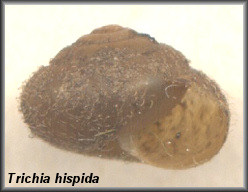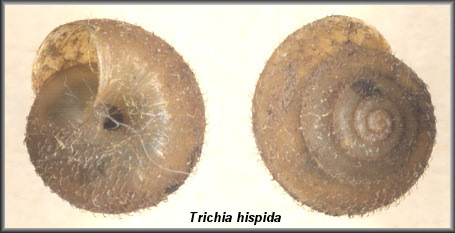|
 On arrival in Jacksonville that night, despite temporary dismay with the
Jaguars' last minute loss to the Titans, I went to microscope, collection,
and books to sort out the identity of this probable vagabond. Conclusion:
I had picked up my second batch (the first was in ME on my 45th birthday)
of Hairy Helicellid, a species native to northwest Europe east through
northern Asia, where it reaches the Amur River. The scientific cognomen is
Trichia hispida (Linnaeus, 1758) (see
first note at bottom of page) [literally: the Hairy (Latin),
Hairy (Greek) Snail], and its taxonomy goes like this: Mollusca:
Gastropoda: Stylommatophora: Pulmonata: Helicoidea: Hygromiidae:
Hygromiinae. Since I wondered how far and how long it had traveled in
North America, I dug further into my library and found
no mention of the species in a host
of state and regional surveys including NH, CT, NY, NJ, OH, IN, IL, MI,
and WI. Nonetheless, I found a few references and, using the Internet
(including good advice from my friends on the Conch-L list-serve), patched
together the following summary over about a ten day period:
On arrival in Jacksonville that night, despite temporary dismay with the
Jaguars' last minute loss to the Titans, I went to microscope, collection,
and books to sort out the identity of this probable vagabond. Conclusion:
I had picked up my second batch (the first was in ME on my 45th birthday)
of Hairy Helicellid, a species native to northwest Europe east through
northern Asia, where it reaches the Amur River. The scientific cognomen is
Trichia hispida (Linnaeus, 1758) (see
first note at bottom of page) [literally: the Hairy (Latin),
Hairy (Greek) Snail], and its taxonomy goes like this: Mollusca:
Gastropoda: Stylommatophora: Pulmonata: Helicoidea: Hygromiidae:
Hygromiinae. Since I wondered how far and how long it had traveled in
North America, I dug further into my library and found
no mention of the species in a host
of state and regional surveys including NH, CT, NY, NJ, OH, IN, IL, MI,
and WI. Nonetheless, I found a few references and, using the Internet
(including good advice from my friends on the Conch-L list-serve), patched
together the following summary over about a ten day period:
CANADA:
NEWFOUNDLAND: "Scattered localities around the province" (Newfoundland Mus.;
Ron Noseworthy, pers. comm. 11/28/04)
NOVA SCOTIA. Halifax. (T. Bland! Binney, 1878); Pictou Co., Granton (Museum
of Comparative Zoology (MCZ);
Dundee, 1974); Wolfville (Moore, 1962); Victoria; Cape Breton Co.;
Inverness Co. (Macmillan, 1953)
PRINCE EDWARD ISLAND. Charlottetown (B. Long! 1912; Pilsbry, 1939)
NEW BRUNSWICK. (MCZ; Dundee, 1974)
QUEBEC. Montreal (Cockerell, 1889); Quebec City (La Roque, 1940)
ONTARIO. Ottawa (La Roque, 1940); Drift, Kemptville Creek (Wayne Grimm!
Fred Schueler pers. comm. 12/15/97); "Scattered but widely distributed on
roadsides, towns, and gardens throughout the Mixedwood Plain ecozone"
(Grimm, 2004; linked below)
UNITED STATES:
MAINE: Knox Co., Rockland and Thomaston (Lermond, 1908).; Hancock Co.,
Stonington (H. G. Lee! 8/2/85; Lee Coll.); [Not recorded for ME by Morse
(1864)]
MASSACHUSETTS. Martha's Vineyard, near Gay Head (J. H. Thomson, 1885; not
collected by Thomson)
VERMONT. Washington Co., Montpelier (before 6/94; University of Florida (UF) 222351)
NEW JERSEY. Atlantic Co., Atlantic City (before 6/94; UF 222607)
NEW YORK. Schoharie Co., 1.4 miles S of Sharon (L. Hubricht! 1958; Field
Museum of Natural History (FMNH)
78676); 3.6 mi NW of Richmondville (L. Hubricht! 1981; FMNH 267849;
267850); Tompkins Co., Taughannock Falls (H. J. Hopman! 10/81; Hopman,
1982)
ILLINOIS.** Cook Co., Glencoe, Chicago Botanic Garden (J. Gerber! 2001;
FMNH uncatalogued); Cook Co., along Skokie River, 0.25 miles west of
Willow Road Dam (J. Slapcinsky! before 12/04; UF 294176).
ALABAMA. Mobile Co., Mobile (before 11/97; UF 97804; identification
confirmed in litt. J. Slapcinsky 12/1/04)
** ILLINOIS. Will Co., Lillycache, near Joliet (E. E. Hand! 1911; FMNH
65020) Stenotrema sp. misidentified as T. hispida on
collection database fide J. Gerber, 11/29/04 in litt.
10/28/04.
Among the special resources on the Internet were an excellent
report on the
landsnail
fauna of the Mixedwood Plain Ecozone of Ontario and Quebec by Wayne
Grimm, images of living snails at
http://www.biopix.dk/Photo.asp?Language=da&PhotoId=14389, and the searchable
databases of the
Florida Museum of Natural History (Gainesville)
and
Field Museum of Natural History (Chicago).
Thus "NEW YORK: 1 mi. south Ithaca College, Ithaca (H. Lee!
11/21/04; Lee Coll.; Carnegie Museum [CM 70366])" can be added to the apparently
expanding range of this little snail, whose peregrinations seem to have
been less extensive (or otherwise less noticed) in our country than across
the eastern portion of our northern neighbor. Of special interest is the
record by Dr. Hopman from Taughannock Falls, near the opposite end of Lake
Cayuga, at a time when the Dutch physics professor found no T. hispida
in Ithaca. Not unlikely the snail has extended its range locally in the
intervening 23 years, and human agency may well be a factor.
How much further it has
spread is an open question, but we can be certain of one thing - we
shouldn't underestimate its potential to girdle the continent as it nearly
has in its native Eurasia, wherein natural enemies are more likely
encountered. Consider this: as of thirty years ago, Trichia hispida
had been intercepted by the U. S. Department of Agriculture in 13 states and the District of Columbia
hitchhiking on 33 species of plants, from shamrock to cauliflower to a
walnut log (as well as military cargo) originating in 17 countries from
Europe to Iran to Australia (Dundee, 1974).
Acknowledgements: I thank Jochen Gerber (FMNH) and John Slapcinsky (FLMNH)
for checking records in their respective collections as well as Tim Pearce
(CM) for solicitation of voucher material. Marien Faber, Richie Goldberg,
Lubos Kolouch, Ron Noseworthy, Aydin Örstan, Jody Thompson, and Tom
Watters of the Conchologists of America Listserver (Conch-L) made helpful suggestions.
Literature cited [the three papers "not seen" were cited by Dundee, 1974]:
Binney, W. G., 1878. Terrestrial Mollusks 5. Bulletin Mus. Comp. Zool.
4: 345. [not seen].
Cockerell, T. D. A., 1889. Notes on the variation of certain Mollusca
introduced from Europe. The Nautilus 3(8): 86-90. Dec.
Dundee, D., S., 1974. Catalog of introduced mollusks of eastern North
America (north of Mexico). Sterkiana 55: 1-37. Sept.
Hopman, H.J., 1982. De eerste schreden. Correspondentieblad van de
Nederlandse Malacologische Vereniging 208: 1293-1299. Sept.
La Roque, A., Checklist of Canadian Mollusca Parts 1-3: 1-359.
[manuscript cited by Dundee, 1974; not seen].
Lermond, N. W., 1908. Hygromia hispida (L.) in Maine. The
Nautilus 21(10): 109. Feb.
Macmillan, G. K., 1953. Preliminary survey of land and freshwater
Gastropoda of Cape Breton, Nova Scotia. Nova Scotian Inst. Sci. 23(4):
398-408. [not seen].
Moore, R. G., 1962. Land Mollusca in the vicinity of Wolfville, Nova
Scotia. Nova Scotian Inst. Sci. 25(3): 187-196. [not seen]
Morse, E. S., 1864. Observations on the terrestrial pulmonifera of
Maine... Jour. Portland Soc. Nat. Hist. 1(1): 1-63 + 10 pls.
Pilsbry, H. A., 1939 Land Mollusca of North America north of Mexico vol
I part 1 part 2. xvii + pp 1-573 + ix. Academy of Natural Sciences,
Philadelphia.
Thomson, J. H., 1885. Journal of Conchology 4: 372.
Note (6/18/2008):
Trichia
Hartmann, 1840, of which this is the type species by subsequent
designation (Herrmannsen, 1849), is actually a junior homonym of the
crustacean genus Trichia De Haan, 1839. In 2004 a petition for
the conservation of the Hartmann nomen was rejected by the International
Commission for Zoological Nomenclature (ICZN), and the earlier
Trochulus Chemnitz, 1786, was considered an objective synonym and
placed on the Official List of Generic Names. [Bull. Z. N. 61(3):
Opinion 2079 (Case 2926) 30 Sept. Thus the vagabond is
more properly referred to as Trochulus hispidus.
*Note (12/20/09): In his description of
Helix hirsuta, Thomas Say (1817: 17) made comparison to Trochulus
hispidus (then Helix hispida). Say's species was ultimately
placed in Stenotrema Rafinesque, 1819, in which genus, although
not the type species, it is the first described. Thus I was not the
first to appreciate the similarity between the two convergent taxa.
Say, T., 1817. Descriptions of seven species of American fresh water and
land shells, not noticed in the systems. Journal of the Academy of
Natural Sciences of Philadelphia 1(1): 13-16. May |

 On arrival in Jacksonville that night, despite temporary dismay with the
Jaguars' last minute loss to the Titans, I went to microscope, collection,
and books to sort out the identity of this probable vagabond. Conclusion:
I had picked up my second batch (the first was in ME on my 45th birthday)
of Hairy Helicellid, a species native to northwest Europe east through
northern Asia, where it reaches the Amur River. The scientific cognomen is
Trichia hispida (Linnaeus, 1758) (see
first note at bottom of page) [literally: the Hairy (Latin),
Hairy (Greek) Snail], and its taxonomy goes like this: Mollusca:
Gastropoda: Stylommatophora: Pulmonata: Helicoidea: Hygromiidae:
Hygromiinae. Since I wondered how far and how long it had traveled in
North America, I dug further into my library and found
no mention of the species in a host
of state and regional surveys including NH, CT, NY, NJ, OH, IN, IL, MI,
and WI. Nonetheless, I found a few references and, using the Internet
(including good advice from my friends on the Conch-L list-serve), patched
together the following summary over about a ten day period:
On arrival in Jacksonville that night, despite temporary dismay with the
Jaguars' last minute loss to the Titans, I went to microscope, collection,
and books to sort out the identity of this probable vagabond. Conclusion:
I had picked up my second batch (the first was in ME on my 45th birthday)
of Hairy Helicellid, a species native to northwest Europe east through
northern Asia, where it reaches the Amur River. The scientific cognomen is
Trichia hispida (Linnaeus, 1758) (see
first note at bottom of page) [literally: the Hairy (Latin),
Hairy (Greek) Snail], and its taxonomy goes like this: Mollusca:
Gastropoda: Stylommatophora: Pulmonata: Helicoidea: Hygromiidae:
Hygromiinae. Since I wondered how far and how long it had traveled in
North America, I dug further into my library and found
no mention of the species in a host
of state and regional surveys including NH, CT, NY, NJ, OH, IN, IL, MI,
and WI. Nonetheless, I found a few references and, using the Internet
(including good advice from my friends on the Conch-L list-serve), patched
together the following summary over about a ten day period: